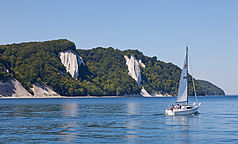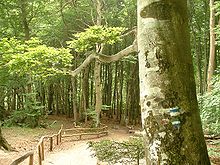Jasmund National Park
| Jasmund National Park | ||
|---|---|---|
| Part of the chalk coast with Victoria viewpoint and Königsstuhl seen from the Baltic Sea | ||
|
|
||
| Location: | Mecklenburg-Western Pomerania , Germany | |
| Surface: | 3,003 ha | |
| Founding: | October 1, 1990 | |
| Address: |
Website of the National Park Jasmund Stubbenkammer 2a D – 18546 Sassnitz |
|
The Jasmund National Park is located on the Jasmund peninsula in the northeast of the island of Rügen in the state of Mecklenburg-Western Pomerania and has existed since September 12, 1990. It is 3,003 hectares (ha) in size, making it Germany's smallest national park . Since June 25, 2011, part of the park's beech forest has been a UNESCO World Heritage Site .
The area of the National Park Jasmund comprises the stocked with original Buchwald ridge of Stubnitz north of the port Sassnitz with the chalk - cliff coast (2.200 ha) (characteristic especially the Stubbenkammer ), a 500 meters in the Baltic Sea in reaching strip of water (603 ha) and 200 hectares in the west of the national park, which are made up of the former Quoltitz chalk quarries , meadows, moors and dry grassland . The highest point on Rügen, the 161 meter high Piekberg , is also located in the national park.
The history of the national park
The natural chalk deposits on the Jasmund peninsula have been mined in chalk quarries for a long time. When in 1926 the reopening of an already disused chalk quarry threatened, the coast north of Sassnitz was designated as a nature reserve . On September 12, 1990, this stretch of coast was declared a national park as part of the national park program.
The chalk cliffs of the Jasmund National Park

The chalk cliffs on the island of Rügen are subject to constant erosion. With every storm, large pieces break out of the rocks and occasionally pull trees and bushes into the sea. Fossils are also extracted : here fossilized remains of sea urchins , sponges and oysters can be discovered. Coastal erosion has increased since larger boulders were removed from the coast in the 19th and 20th centuries to use them to build ports. The boulders acted as natural breakwaters in front of the chalk cliffs; since they were removed, the water of the Baltic Sea has been penetrating the cliffs with unbroken force.
The most striking point of the national park is the 118 meter high chalk cliff Königsstuhl , which was included in the area of the new visitor center in 2004. An average of 300,000 people a year step onto the platform of this chalk cliff protruding from the coastline in order to be able to look out over the Baltic Sea and the imposing neighboring coastline.
As a special phenomenon, the Wissower clinics have also achieved world fame, although they have been largely destroyed since February 24, 2005 after a major bank demolition. It is often mistakenly assumed that these were immortalized by Caspar David Friedrich in his painting Chalk Cliffs on Rügen in 1818 . In his time, around 200 years ago, there were also other chalk rock formations on Jasmund's coast, such as the chalk columns in the Großer Stubbenkammer - i.e. the gorge directly north of the Königsstuhl - and the Kleine Stubbenkammer, which was very similar to the chalk protrusions of the crashed Wissower Klinken at the time directly south of the Königsstuhl. The view of his chalk cliffs on Rügen corresponds almost exactly to the steel engraving Small Stubbenkammer by Johann Friedrich Rosmäsler (in the Stralsund City Archives), which he created in 1834.
The chalk cliffs of the Jasmund National Park are the motif of a special postage stamp that was issued by the Federal Ministry of Finance in January 2012 in the series “German National and Nature Parks”.
The chalk coast of Jasmund was added to the list of 77 national geotopes awarded in 2006.
On the island of Bornholm there is the counterpart to the chalk cliffs, as they used to be connected.
Waters
Several streams arise in the moors of the national park, such as (from southwest to north) Steinbach , Lenzer Bach, Wissower Bach, Leescher Bach, Kieler Bach and Brisnitzer Bach as well as Krietbach and Kollicker Bach. Several of them flow over the chalk cliffs into the Baltic Sea and form some of the few waterfalls in the north German lowlands .
fauna and Flora
Due to its special geological conditions, the Jasmund National Park is home to numerous rare plants and animals. In particular, it protects the largest contiguous beech forest area on the German Baltic Sea coast.
In the forests of the Stubnitz there are numerous water-filled, drainless depressions and hollows, which mostly arose as ice-age dead ice holes . So-called boiler bogs arise where these bodies of water silt up . Numerous black alder can be found in these depressions and kettle bogs. Wild pear , wild apple , service tree and yew can be found in drier places . Among the occurring here orchids also counts Lady's Slipper . Another special feature is the salt vegetation on the north coast of the national park.
The animal world in the national park area is rich in species and diverse. 1,000 species of beetles live in or on wood alone. In the clear streams that run through the Stubnitz forests, there is an unusual inhabitant, the alpine strudel worm, which otherwise only occurs in the mountains. The kingfisher can also be seen on these streams .
In the cliffs of chalk cliffs nesting house martins and the Kreideeule , a cream-colored moth, has its only occurrence in Germany on Jasmund.
Due to the high visitor pressure, however, peregrine falcons and white-tailed eagles are rarely seen in the national park.
Visitors
Since its creation in 1990, the Jasmund National Park has attracted hundreds of thousands of visitors every year. One of the main tasks of the national park administration is therefore also to direct these visitor flows in order to guarantee a largely undisturbed development of the diverse habitats of the national park and still give the visitors an insight into the nature of the national park. The high bank path runs along the coastline above the steep bank and can be used for hiking. The Königsstuhl National Park Center was opened in March 2004 .
The direct connection is via local public transport as well as on foot or by bike. Several bus lines of the Vorpommern-Rügen transport company run to the surrounding parking lots and to Sassnitz, under line 20 to the southern part of the island ( Königsstuhl - Sassnitz - Binz - Göhren - Klein Zicker ).
literature
- National Park Office Vorpommern (Ed.): Chalk cliffs by the sea. Born 2007 (leaflet)
- Stephanie Puffpaff: Nature conservation mapping and assessment of the water structure of the Jasmund National Park, taking into account certain water bodies as wet habitats of Appendix II species of the Fauna-Flora-Habitat Directive. (PDF - 11 MB) 2008, p. 115 , accessed on July 29, 2012 .
- Literature about the Jasmund National Park in the State Bibliography MV
- Christina Paulson: The karst moors in the chalk landscape of the Jasmund National Park on the island of Rügen , dissertation 2001, Greifswalder Geographical Works.
Filmography
- In the Jasmund National Park . Documentary, 45 min., Germany, 1998, by Ina Knobloch and Manfred Praxl, production: City Media TV Frankfurt, distribution: Complete-Media-GmbH, Grünwald ( ISBN 3-89672-491-6 ), short description ( memo from 30. September 2007 in the Internet Archive ) of the MDR
Web links
- Ordinance on the establishment of the Jasmund National Park of September 12, 1990
- Jasmund National Park , official website
- Königsstuhl visitor center
- Overview map
- Bodo Noack: Sources and streams in the Jasmund National Park , September 1993.
Individual evidence
- ^ Message in the ARD Tagesschau ( Memento from June 28, 2011 in the Internet Archive ) from June 25, 2011; the application to place in December 2009; (8.7 MB PDF)
- ↑ See leaflet Chalk Cliffs by the Sea
- ↑ Hans-Dieter Krienke, Hilmar Schnick: Built from small lime shells - The chalk coast of Jasmund on Rügen. In: Ernst-Rüdiger Look, Ludger Feldmann (Ed.): Fascination Geology. The important geotopes of Germany , E. Schweizerbart'sche Verlagsbuchhandlung, Stuttgart 2006, ISBN 3-510-65219-3 , 26f.








